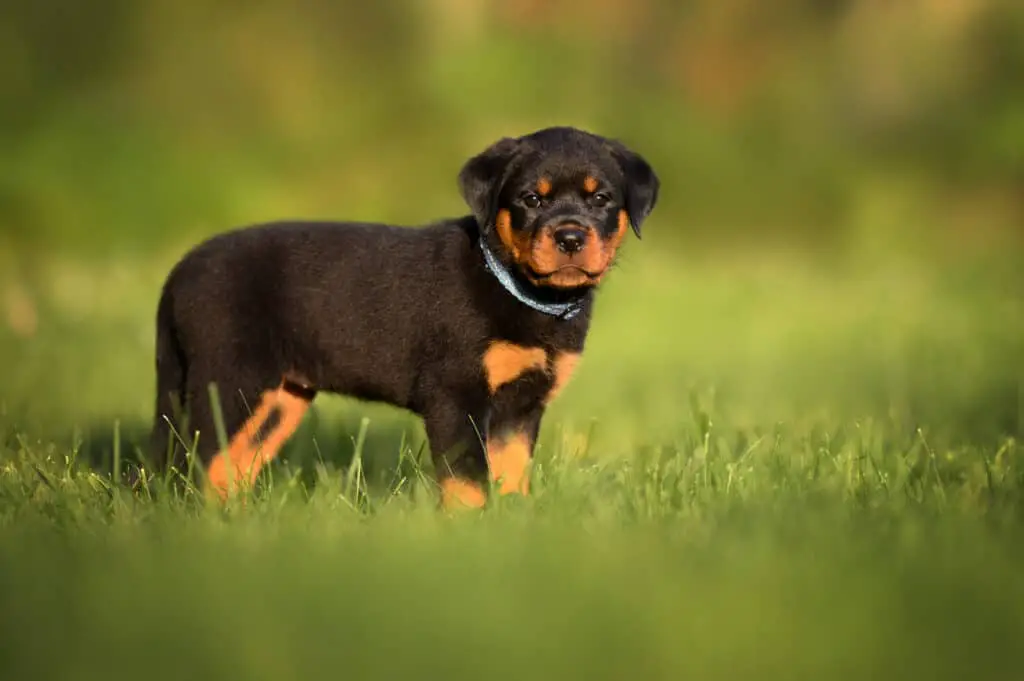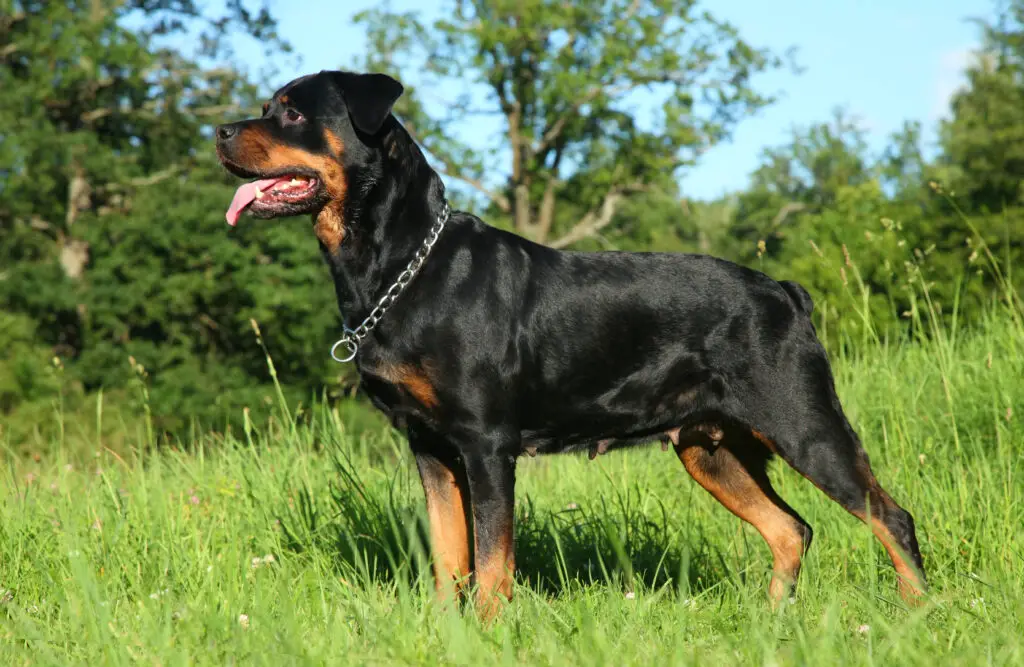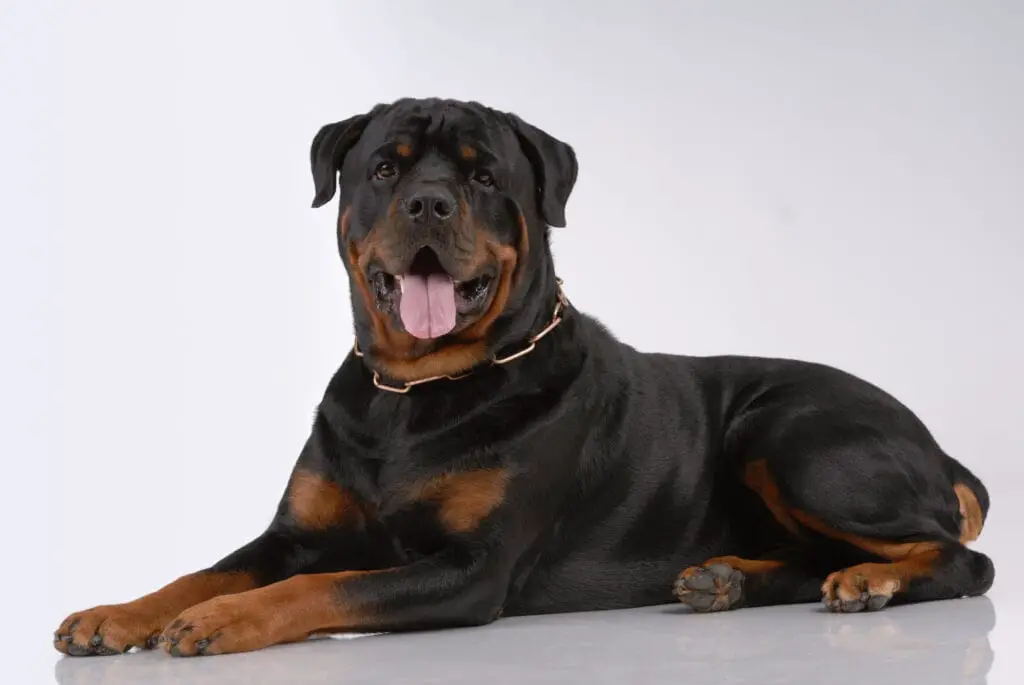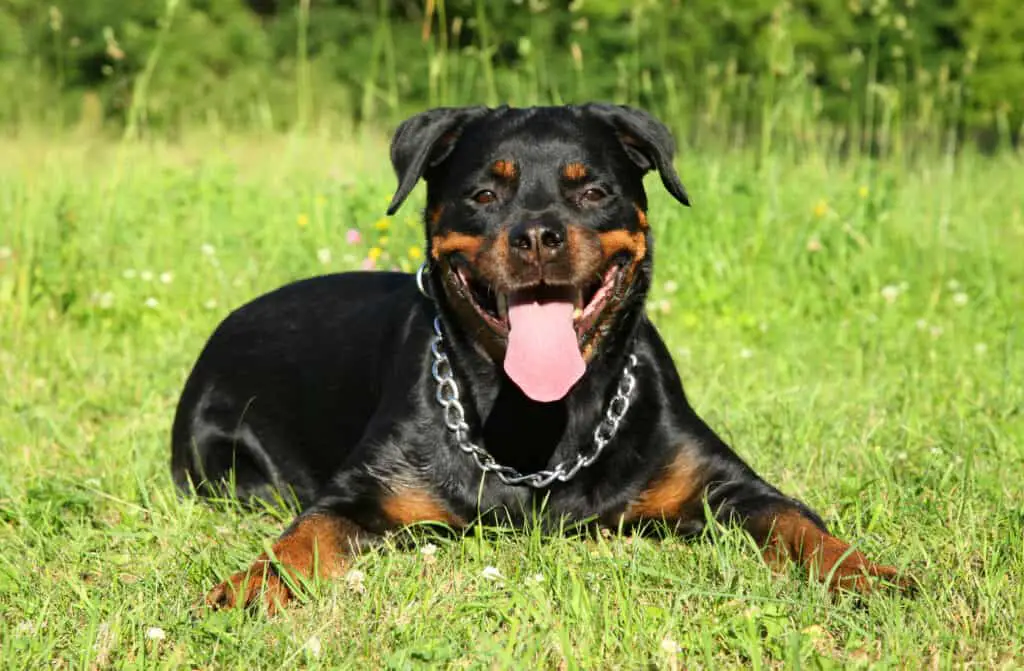Our website is supported by our users. We sometimes earn money when you click an affiliate link and make a purchase. This is at no extra cost to you and helps us to create quality content. Thank you for your support. For all that have shown us such wonderful support, we thank you from the bottom of our hearts!
If you are looking for a loyal and protective dog breed, the Rottweiler might be the perfect match for you. Originally bred in Southern Germany as a herding dog, the Rottweiler is now known for its strength, courage, and intelligence.
Despite their tough exterior, Rottweilers are also known for their affectionate and playful nature, making them great family pets.

One of the most distinctive features of the this dog is its black and tan coat, which is short, thick, and glossy. They are a medium to large breed, with males typically weighing between 95 and 135 pounds, and females weighing between 80 and 100 pounds. Rottweilers are also known for their powerful jaws, which can exert a bite force of up to 328 pounds.
While they can make great companions, it’s important to note that they require a lot of training and socialization from a young age. They are a strong and dominant breed, and without proper training, they can become aggressive and difficult to handle.
However, with the right training and care, Rottweilers can be loyal and loving members of your family for years to come.
History of the Rottweiler
The Rottweiler has a long and storied history that dates back to ancient Rome. These dogs were originally bred as working dogs to help herd and drive livestock, carts, and other animals. They were also used as drover dogs to help move cattle to the butcher.
The dog we know today is descended from mastiffs that lived in the Roman Empire more than 2,000 years ago. These rugged dogs accompanied Roman legions north through the Alps, since these dogs were kept as herder or driving dogs. In the town of Rottweil, Germany, these dogs met and mixed with the native dogs in a natural crossing.
The dogs that emerged from this breeding were known as Rottweiler Metzgerhunds, or Rottweil butchers’ dogs.
It wasn’t until the 2nd century that the Romans abandoned most of their locations in Europe, leaving what would become the Rottweiler in Rottweil, Germany, after which the dog was named. Of course, the Rottweiler of the 2nd century was very different from the Rottie today.
Over the centuries, the Rottweiler continued to be used as a working dog, particularly in its native Germany. These dogs were prized for their strength, intelligence, and loyalty, and they were used for a variety of tasks, including pulling carts, guarding homes and property, and even serving as police dogs.
Today, this dog remains a popular breed around the world, prized for its intelligence, loyalty, and versatility. Whether you’re looking for a faithful companion or a hard-working working dog, the Rottweiler is an excellent choice.
The Rottweiler was recognized as a breed by the American Kennel Club (AKC) in 1931
Physical Characteristics of the Rottweiler
The Rottweiler is one of the large dog breeds known for its robust, powerful, and muscular appearance. This breed typically weighs between 80 to 100 pounds and stands at a height of 24 inches at the withers for males and 22 inches for females.
The Rottie’s coat is short and black with tan markings. They have a broad chest and a strong, muscular neck. Their eyes are almond-shaped and dark in color. The tail is typically docked, which means it is surgically removed when the dog is still a puppy.
One of the most distinctive features of the Rottweiler is its black coat with well-defined rust-colored markings on the cheeks, muzzle, and eyebrows. These markings can also be found on the chest and legs.
The Rottweiler’s build denotes great strength and agility, making it an excellent working dog.
They are often used as guard dogs, draft dogs, guide dogs, rescue dogs, and police dogs.
In terms of temperament, the Rottie dog is steady, alert, self-assured, fearless, devoted, confident, good-natured, and obedient. They are intensely loyal and protective of trusted family members. This breed also has a playful and affectionate side that it reveals when at ease.
Overall, it is a breed that commands respect and admiration. With their striking appearance and impressive physical characteristics, they are a breed that is sure to turn heads wherever they go.
Temperament & Training of the Rottweiler
It is a breed that is known for its strength, intelligence, and protective nature. As a powerful breed and a natural guard dog, with strong jaws they are often seen as aggressive. This just means that they need proper, consistent training and socialization for a your dog to become a well-behaved companion.
They have a self-assured and a seemingly aloof personality, which can sometimes come off as dominant or aggressive if not trained properly. This is why socialization from an early age is essential for a Rottie to learn how to interact with people and other animals in a calm and friendly manner.
When it comes to training, positive reinforcement is the most effective method for a Rottweiler. They are intelligent dogs that respond well to consistent and patient training. Rottweilers excel in tasks such as tracking and agility, making them excellent working dogs.

However, they also make great companions for families with children as long as both the Rottweiler and children are properly trained and socialized.
It is important to note that Rottweilers have a wait-and-see attitude, which means they may take a moment to assess a situation before reacting.
This can sometimes be mistaken for aloofness, but it is simply a part of their protective nature. Rottweilers are loyal and alert, making them great guard dogs, but they also have a gentle side and can be a loving and playful companion.
In summary, the Rottie is a breed with a strong personality that requires proper training and social skills to become a well-behaved companion. They are intelligent, protective, and loyal dogs that excel in various tasks such as tracking and agility.
With consistent and patient training, a Rottweiler can be a great addition to any family as a gentle playmate or a reliable guard dog.
Health Issues of the Rottweiler
As Rottweiler pet parents, it’s important to be aware of the potential health issues that your furry friend may face. Here are some of the most common health problems that Rottweilers may encounter:
Hip Dysplasia
Hip dysplasia is a condition where the hip joint becomes lax, leading to pain, instability, and the eventual erosion of the joint. Unfortunately, Rottweilers are particularly susceptible to hip dysplasia, so it’s important to keep an eye out for any signs of discomfort or pain when they’re walking or running.
Regular exercise can help keep their joints healthy, but it’s important not to overdo it, especially when they’re young.
Obesity
Rottweilers are a large breed, and they require a lot of food to maintain their weight. However, it’s important to make sure that they’re not overeating, as obesity can lead to a number of health problems, including joint pain, heart disease, and diabetes.
Make sure to feed your Rottweiler a balanced diet that’s appropriate for their age and activity level, and avoid giving them too many treats.
Progressive Retinal Myopathy
Progressive Retinal Atrophy (PRA) is a genetic eye disorder that can affect Rottweilers, among other breeds.
This condition leads to the gradual deterioration of the photoreceptor cells in the retina, ultimately resulting in blindness. PRA is hereditary, and in Rottweilers, it typically becomes evident as the dog ages.
The initial signs of PRA in Rottweilers often include night blindness, where affected dogs struggle to see in low-light conditions.
As the disease progresses, day vision is also compromised, eventually culminating in complete blindness. Due to its genetic nature, responsible breeding practices are crucial in mitigating the prevalence of PRA in Rottweilers.
While there is no cure for PRA, early detection through regular veterinary eye examinations can aid in proactive management. Owners of Rottweilers diagnosed with PRA can implement supportive measures to help their dogs adapt to diminishing vision, such as maintaining a consistent environment and using verbal cues.
Despite the challenges, affected Rottweilers can lead fulfilling lives with dedicated care and understanding from their owners. Regular veterinary monitoring is key to optimizing the quality of life for Rottweilers affected by Progressive Retinal Atrophy.

Gastric Dilatation-Volvulus (GDV) a.k.a. Bloat
Bloat, scientifically known as Gastric Dilatation-Volvulus (GDV), is a life-threatening condition that can affect Rottweilers.
This emergency situation occurs when a dog’s stomach fills with gas, causing it to expand and potentially twist on itself. Rottweilers, with their deep chests, are among the breeds more prone to this condition.
In the case of bloat, the twisting of the stomach not only leads to the compression of blood vessels but also obstructs the normal flow of gases and fluids. This results in a rapid deterioration of the dog’s condition, leading to shock and organ damage.
Recognizing the symptoms of bloat in Rottweilers is crucial for swift intervention. Signs may include a distended abdomen, unproductive attempts to vomit, restlessness, excessive drooling, and a rapid heartbeat. Bloat is a medical emergency that requires immediate veterinary attention.
Preventive measures such as feeding Rottweilers multiple smaller meals throughout the day, avoiding vigorous exercise right after meals, and using elevated feeding bowls can help reduce the risk of bloat. Pet owners should be vigilant, understanding the urgency of seeking veterinary care if they suspect their Rottweiler is experiencing this life-threatening condition.
Regular visits to the vet can help catch any potential problems early on, so make sure to schedule checkups at least once a year.
Consistent Exercise
Rottweilers are a high-energy breed, and they require consistent exercise to stay healthy and happy. Make sure to take your Rottweiler for daily walks or runs, and provide them with plenty of opportunities to play and explore. Regular exercise can help prevent obesity and other health problems, and it can also help keep your Rottweiler’s joints healthy.
Appropriate Weight
Maintaining an appropriate weight is important for Rottweilers, as excess weight can put strain on their joints and lead to health problems. Make sure to monitor your Rottweiler’s weight regularly, and adjust their diet and exercise routine as needed to keep them at a healthy weight.
Overall, while Rottweilers may be prone to certain health problems, with proper care and attention, you can help keep your furry friend healthy and happy for years to come.
Grooming Your Rottweiler
Taking care of your Rottweiler’s grooming needs is an important part of keeping them healthy and happy. Here are some tips on how to groom your Rottweiler:
Brushing
Brushing your Rottweiler’s coat regularly is important to keep it healthy and shiny. Most grooming experts recommend using a dual-sided bristle/pin brush, a slicker brush, and a de-shedding tool for coat care.
The bristle side is good for puppies or dogs that are not used to being brushed, while the pin side will help remove dead hairs and stimulate healthy oil production in adults.
Brushing your Rottweiler’s coat also helps to distribute natural oils and prevent matting.
Bathing
Bathing your Rottweiler is another important part of their grooming routine. It is recommended to bathe your Rottweiler every 6-8 weeks, or as needed.
Use an all-natural and moisturizing shampoo to avoid drying out their skin and coat. Before bathing, brush your Rottweiler’s coat to remove any loose hairs or debris. Be sure to rinse thoroughly to avoid any residue left on their skin.
A helpful tool to get down the skin and really get a good massage in is this ELEGX Pet Grooming Bath Massage Brush.

Cutting Fur/Hair
Trimming your Rottweiler’s fur or hair is not necessary, but it can help keep them cool in hot weather. Use scissors or clippers to trim any long hair around their ears, paws, and tail. Be careful not to cut too close to their skin, as this can cause irritation.
We like these GLADOG Professional Grooming Scissors for Dogs with Safety Round Tips.
Clipping or Grinding Nails
Keeping your Rottweiler’s nails trimmed is important to avoid overgrowth and discomfort. Use a clipper or grinder to trim their nails, being careful not to cut the quick (the pink part of the nail that contains blood vessels).
If you are unsure how to trim their nails, consult with a veterinarian or professional groomer. Also you can check out our article: How to Grind Your Dog’s Nails Safely
Dental Care
Dental care is important for your Rottweiler’s overall health. Brush their teeth regularly with a
dog toothbrush and toothpaste to prevent tartar buildup and bad breath.
As your dog or puppy grows more accustomed to the brushing process, start by brushing just a few teeth at a time and progressively increase the number of teeth you brush. To maintain your dog’s mouth healthy and clean, you should ideally brush their teeth at least once a day.
You can also provide dental chews or treats to help keep their teeth clean.
GREENIES Original Regular Natural Dog Dental Care Chews is one well-known brand. These may cause allergies since they include wheat and wheat gluten. The Nylabone Nutri Dent Natural Dental Chew Treats are another well-liked type that also incorporates wheat.
Please check the ingredients before giving your dog any goodies. Experts have started steering clear of items that contain substances that may not be as beneficial for dogs as once believed.
Protein from potatoes and peas is currently thought to have negative effects. Therefore, limiting your dog’s exposure to these ingredients may be a smart idea until additional information and completed studies are available.
Cleaning Ears
Cleaning your dog’s ears regularly can help prevent infections and discomfort. Use a gentle ear cleaner and cotton balls to wipe out any debris or wax from their ears. Be sure not to insert anything into their ear canal, as this can cause damage.
A convenient option are these ear wipes. They are great if you have limited storage space or if you are traveling.
Keeping up with your Rottweiler’s grooming needs can help keep them healthy and happy. By following these tips, you can ensure that your Rottweiler looks and feels their best.
Owning a Rottweiler

If you are considering owning a Rottweiler, it is important to understand the costs associated with purchasing and maintaining one. The cost of a puppy can vary depending on the breeder, location, and the dog’s lineage.
On average, you can expect to pay between $1,500 to $3,500 for a puppy from a reputable breeder. However, some breeders may charge more for dogs with exceptional lineage or unique features.
In addition to the initial cost of purchase, you should also consider the ongoing maintenance costs of owning a Rottweiler. They require special training to ensure they are well-behaved and socialized. This training can be done through obedience classes or with the help of a professional trainer. The cost of training can vary depending on the trainer and the length of the program.
Medical costs are another factor to consider when owning one of these black beauties. Rottweilers are prone to certain health issues such as hip dysplasia, elbow dysplasia, and bloat. It is important to keep up with regular check-ups and vaccinations to ensure your dog stays healthy. You should also consider the cost of emergency veterinary care should your dog become ill or injured.
Grooming costs are another expense to consider when owning. Rottweilers have a short, dense coat that requires regular brushing to keep it healthy and shiny. They also shed moderately year-round and heavily twice a year. You may also need to trim their nails and clean their ears regularly.

If you are interested in adopting a Rottweiler, it is important to research breeders carefully. Look for breeders who are registered with reputable organizations and who have a good reputation. You may also want to consider adopting a Rottweiler from a rescue organization.
Rescue dogs can be a great option for those who want to give a dog a second chance at a loving home.
Fun facts about Rotties include that they were originally bred in Germany as herding dogs and were also used as guard dogs.
They are known for their loyalty and protective nature and make great therapy dogs. Rottweilers have a life span of 8-10 years and are subject to certain breed-specific legislation in some areas.
Overall, owning a Rottweiler can be a rewarding experience but it is important to consider the costs and responsibilities associated with owning one. With proper care, training, and attention, your Rottweiler can be a loving and loyal companion for many years to come.
Frequently Asked Questions
What are the characteristics of a Rottweiler?
Rottweilers are known for their muscular build, large size, and black and tan coloring. They are often described as confident, loyal, and protective dogs. They are intelligent and require regular exercise and mental stimulation.
Are Rottweilers good pets?
Rottweilers can make excellent pets for the right owner. They are loyal and protective of their family, but they do require proper socialization and training. They are not recommended for first-time dog owners or those who are not willing to put in the time and effort to train and care for them properly.
What is the average size of a Rottweiler?
The average height for a male Rottweiler is 24-27 inches at the shoulder, and for a female Rottweiler, it is 22-25 inches. The average weight for a male Rottweiler is 95-135 pounds, and for a female Rottweiler, it is 80-100 pounds.
What breeds are commonly mixed with Rottweilers?
Rottweilers are often mixed with other breeds, such as Labrador Retrievers, German Shepherds, and Pit Bulls. These mixed breeds can inherit traits from both breeds and can make great pets with proper training and socialization.
What are the strengths of a Rottweiler?
Rottweilers are strong, confident, and protective dogs. They are loyal to their family and make excellent guard dogs. They are intelligent and can excel in obedience training and other activities, such as agility and tracking.
What are the weaknesses of a Rottweiler?
Rottweilers can be stubborn and require proper training and socialization. They can also be prone to certain health issues, such as hip dysplasia and obesity. They can also be aggressive towards other dogs and strangers if not properly socialized.
The Bottom Line on this Loyal and Smart Guard Dog

In conclusion, Rottweilers are a versatile breed that can serve as guard dogs, draft dogs, rescue dogs, and police dogs.
They are strong, athletic, and alert, with a desire to please their owners. They enjoy dog sports like barn hunt, herding, agility, dock diving, nose work, and tracking, and carting.
When it comes to their physical characteristics, Rottweilers are a large breed with a short, black coat that requires minimal grooming. They are typically between 22 and 27 inches tall and can weigh up to 135 pounds. Rottweilers have a lifespan of around 8 to 10 years.
It’s important to note that Rottweilers require early socialization and training to ensure they become well-behaved and obedient dogs. They can be stubborn at times, but with proper training, they can become loyal and loving companions.
When considering adopting a Rottweiler, it’s important to find a reputable breeder to ensure quality and avoid potential health issues.
The average cost of a Rottweiler puppy is between $1,000 and $2,500, but this can vary based on the dog’s quality and lineage and the location and quality of the breeder.
Overall, Rottweilers are a great breed for those who are willing to put in the time and effort to train and socialize them properly. They are loyal, protective, and loving companions that will bring joy to your life for many years.
Please read our Legal Disclaimer







